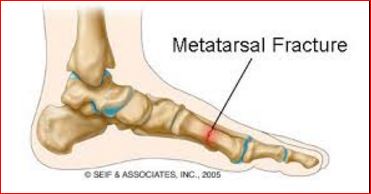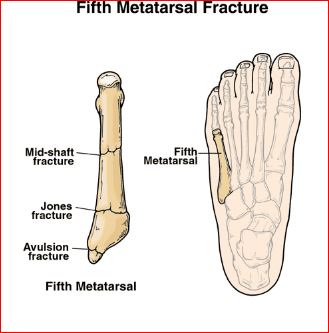What Is Metatarsal Fracture?
Metatarsals are the five long bones of the midfoot. A Metatarsal Fracture occurs when one of these long bones is broken due to stress fracture (repeated stress), or due to an acute fracture (sudden injury) which normally affects sportsmen.
Acute fractures are associated with a sound when breaking, pain, swelling, bruising and difficulty in walking. Stress fractures share similar signs except for the bruising.

Anatomy of your foot
The foot consists of multiple bones, muscles, tendons and soft tissues. The foot has 26 bones:
- Fourteen phalanges or toe bones with three for the small toes and two for the big toe.
- Seven tarsal bones making up the back part of the foot (hindfoot) and heel (calcaneum).
- Five Metatarsals are long and named from the first bone connected to the big toe to the fifth.
Each Metatarsal normally consists of a base which is adjacent to the heel, a shaft which consists of the straight part of the bone, a head and a holding neck..
The fifth Metatarsal Bone has slight differences as it has a bulging (tuberosity) at its base. Your foot’s bones, ligaments, and tendons form arches, one lengthways and one across the foot known as the longitudinal and transverse arches. They allow your foot to hold up the weight of your body.
Types
The metatarsal bones are some of the most commonly broken (fractured) bones in the human foot. There are two main types of this kind of fractures:
- Acute fracture that occurs as a result of sudden (acute) injury to the foot like a heavy object dropping on the foot, falling, or a sporting injury.
- Stress fracture that is brought about by overuse or repetitive injury to a normal metatarsal bone.
Metatarsal fracture
Metatarsal fractures easily occur if the metatarsal bones weaken as a result of ‘thinning’ of the bones (osteoporosis).
Generally, fractures can be:
- Open or closed: which is where the skin is broken over the fracture leaving an opening for possible infection into the broken bones. The soft tissues around the ankle damaged making it a serious type of fracture.
- Displaced or not displaced: in this, the bones slip out of alignment due to breaking. The bones need proper alignment thus the need for a specialist.

Acute metatarsal fractures
Acute metatarsal fracture/breaks can either be displaced or non-displaced and could be open or closed as well. Open metatarsal fracture is normally due to severe trauma like a road accident.
The most common bone to fracture in sudden/acute is the fifth metatarsal bone. The other metatarsal bones can also break at various points along their length with the first, second and fifth metatarsals getting injured in sports mostly.
Causes
Acute fractures normally result from direct injury as a force acts directly to the foot. Twisting of the foot or the ankle can result in fractures of the base of the fifth metatarsal as well.
In this injury, the twisting mechanism pulls on a strong ligament attaching to the base of the fifth metatarsal then pulling off a fragment of bone. The shaft of the metatarsal is mostly injured due to twisting of the foot upon landing from a jump.

Symptoms
You may hear a sound when breaking, with an immediate pain and tenderness around the area of the fracture. Movement of your foot may also be limited but the pain can settle within a few hours. The pain is often referred to as ‘pinpoint pain’ as it is quite well localized at the site of impact to the bone.
Bruising and swelling can happen since broken bones bleed and one might experience difficulties putting weight on the affected foot.
Investigations
Can be identified through the use of;
- MRI scanning
- X-ray.
- CT scanning
Treatment
This depends on various factors as listed below.
- The severity of the damage.
- The broken metatarsal bone
- The part of the bone broken.
Principles of treatment
1. Simple painkillers
They help in relieving pain. Common painkillers include paracetamol and non-steroidal anti-inflammatory painkillers.
2. Ice
Applying ice to your foot as soon as possible after injury can also be helpful as pain relief. Applying ice for less than 10 minutes have little effect while doing it for more than 30 minutes may damage the skin. Ice should not be put directly next to skin, as it may cause ice burn but should be wrapped instead.
The ice pack should be gently pressed onto the injured part. This relieves pain since the cold reduces blood flow to the damaged ligaments.
3. Elevation
This is normally keeping the foot on a chair to at least hip level when sitting or put your foot on a pillow to reduce swelling when in bed.
4. Rest
Resting may be the only treatment required even in a traumatic fracture.
5. Avoiding the offending activity
This may require the use of crutches or even a wheelchair as it is important to remove any stress from the foot for healing.
6. Immobilization
Some fractures just require support to heal like a supportive Tubigrip®-type dressing with a supportive, rigid shoe. Other fractures need a below-the-knee plaster cast treatment.
7. Surgery
Surgery may be a necessity in, for instance, re-aligning any part of the bone that may have slipped out of position.
8. Follow-up care
This includes physical therapy and a gradual return to exercise. They are normally considered as a part of good follow-up care.
It normally takes around six to eight weeks for acute metatarsal fracture to heal but may take longer than this for a sportsman before embarking fully back into action.
References
- Maitra RS, Johnson DL. Stress fractures. Clinical history and physical examination. Clin Sports Med. 1997 Apr. 16(2):259-74. [Medline].
- Ekstrand J, van Dijk CN. Fifth metatarsal fracture among male professional footballers: a potential career-ending disease. Br J Sports Med. 2013 Apr 9. [Medline].
- Rongstad KM, Tueting J, Rongstad M, Garrels K, Meis R. Fourth Metatarsal Base Stress Fractures in Athletes: A Case Series. Foot Ankle Int. 2013 Feb 5. [Medline].
- Hockenbury RT. Forefoot problems in athletes. Med Sci Sports Exerc. 1999 Jul. 31(7 suppl):S448-58. [Medline]
